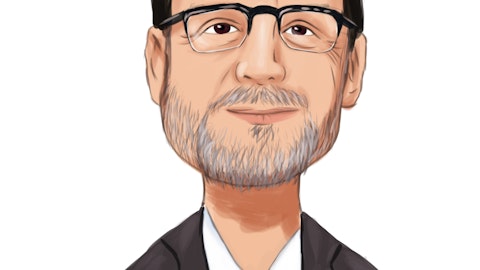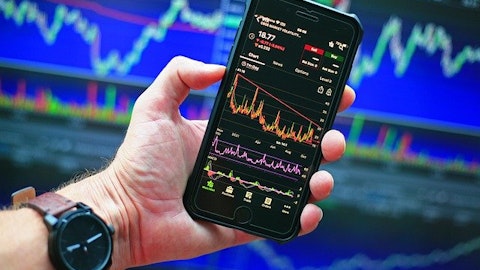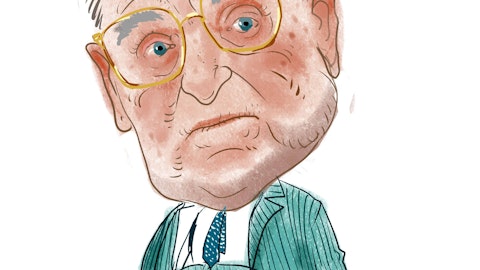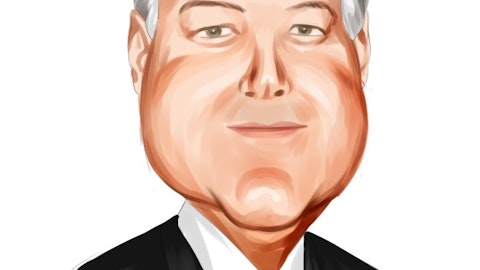In this article, we discuss George Soros’ 2022 portfolio: 10 value stock picks. If you want to skip our detailed analysis of Soros’ history, investment philosophy, and hedge fund performance, go directly to George Soros 2022 Portfolio: 5 Value Stock Picks.
George Soros was born in 1930 in Budapest. He survived the Nazi occupation of Hungary during World War II. In 1947, he came to London and was enrolled at the London School of Economics. As a student, Soros also worked as a railway porter and waiter. In 1951, he received a Bachelor’s degree in philosophy, and in 1954, he completed his Master’s in philosophy.
Soros started his journey in the world of finance by joining the merchant bank Singer & Friedlander after completing his education. He started as a clerk but soon after he got himself shifted to the arbitrage department. From 1956 to 1959, he went to New York and applied his skills as an arbitrage trader at F. M. Mayer. European stocks were his area of expertise, which were gaining momentum following the creation of the Common Market, now known as the European Union.
After a stint of three years at F. M. Mayer, Soros joined Wertheim & Co., where he worked until 1963 as an analyst in European stocks. During this time, he came up with the theory of reflexivity, which extended the work of his teacher Karl Popper at the London School of Economics. He stated that the market values of assets are driven by the error-prone ideas of participants and not by the economic fundamentals of the situation. Ideas and events impact each other in reflexive feedback loops. He also added that this results in markets going through “virtuous” or “vicious” cycles. His theory negated the neoclassical economics through market equilibrium that was prevalent at that time.
Soros Fund Management
George Soros joined Arnhold and S. Bleichroeder in 1963 as a Vice President, where he had a lackluster start as the business was slow following the imposition of the Interest Equalization Tax. In 1969, Soros started the Double Eagle hedge fund, which was his first hedge fund. He gathered $4 million from investors along with $250,000 of his own. The hedge fund was a step forward from the Double Eagle fund that was created by Soros and Chairman Henry Arnhold in 1967. Soros created the Soros Fund Management in 1970, and three years later, he resigned from his position in the Double Eagle Fund to focus on his fund and avoid any conflict of interest.
During the 1990s, he benefitted from two major global economic crises. In 1992, Soros took a significant short position in the pound as he understood the weak position of the UK currency in the exchange rate mechanism of the EU. He took a $10 billion position by shorting pounds, and the position finally yielded results when the UK left the European Exchange Rate Mechanism and devalued its currency. Soros received a tailwind of $1 billion. He was termed as “the man who broke the Bank of England.”
In early 1997, the value of the Thai baht started to look vulnerable as the Japanese banks started to repatriate capital due to a domestic crisis. The value of 25 baht was pegged to $1. The Bank of Thailand (BoT) banned the supply of Thai baht to foreigners. In July, the BoT free-floated the baht, and it lost 14% to 19% of its value in a single day, which caused Thailand to seek the help of the IMF. The aftereffects of the crisis spread across the region as the central bank of the Philippines was forced to spend $540 million in a single day to stop its currency from significant devaluation. Malaysia’s currency was later forced to depreciate itself.
According to Forbes, George Soros’ net worth stands at $8.6 billion as of May 2022. He is considered one of the most generous philanthropists in the world as he has given away more than $32 billion to fund the efforts of the Open Society Foundation globally. As of Q1 2022, Soros’ portfolio value stands at $6.57 billion, with a stake in popular companies such as Amazon.com, Inc. (NASDAQ:AMZN), Alphabet Inc. (NASDAQ:GOOG), and Salesforce, Inc. (NYSE:CRM).
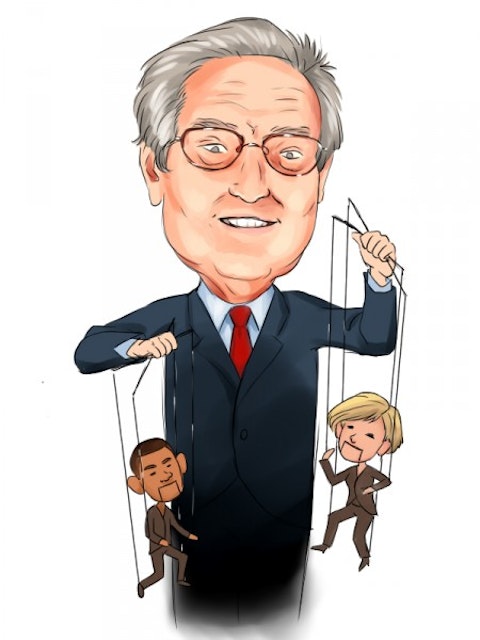
Our Methodology
These stocks have been picked from the Q1 2022 portfolio of Soros Fund Management. All the stocks have a price-earnings ratio of less than 15, indicating the undervaluation of companies. The business fundamentals and earnings have been analyzed to gain a better perspective of the value each stock is expected to generate in the future.
George Soros 2022 Portfolio: 10 Value Stock Picks
10. D.R. Horton, Inc. (NYSE:DHI)
Soros Fund Management’s Stake Value: $224,602,000
Percentage of Soros Fund Management’s 13F Portfolio: 3.41%
Number of Hedge Fund Holders as of December 31: 54
PE Ratio (TTM): 4.93
D.R. Horton, Inc. (NYSE:DHI) is the biggest home construction company in the US according to volume. The Arlington, Texas-based firm could offer a significant upside to investors as the home inventories are at a decade low of around 470,000. Although the mortgage rates are on the rise, D.R. Horton, Inc. (NYSE:DHI) has a history of generating significant returns when mortgage rates have been in double-digits. D.R. Horton, Inc.’s (NYSE:DHI) low price-earnings ratio highlights that the stock is already showing signs of a bear market and could be considered by investors for the long term.
D.R. Horton, Inc. (NYSE:DHI) was mentioned in the Q1 2022 investor letter of Third Avenue Management. Here’s what the investment management firm said:
“Outside of these additions, the Fund also sold “out-of-the-money” put options on the common stock of D.R. Horton, Inc. (“DR Horton”)-the largest homebuilder in the U.S. that accounted for nearly 1 out 9 new homes sold in the U.S. last year. Having followed the company for years, Fund Management can say without hesitation that DR Horton is an incredibly efficient builder focused on delivering quality product at the entry-level price point (its average selling price was less than $325,000 last year) with leading positions in key Sunbelt markets including Dallas, Houston, Austin, Atlanta, and Phoenix.
While the near-term outlook for DR Horton is somewhat uncertain given mortgage rate and supply chain volatility, the medium-to-long-term prospects for volume-based homebuilders with super-strong balance sheets and scale advantages seem promising (such as DR Horton and Lennar Corp.) in Fund Management’s view. This is especially the case when considering that:
-
Residential inventories are at record- low levels in most major markets whether gauged by “month’s supply” or aggregate units available,
-
Demand for single- family residences is accelerating as the largest generation in U.S. history (the “millennial cohort”) enters its prime home buying years and desires more space not only due to “life events” but also “remote” and “hybrid” working arrangements, and
-
Significant inflation in rental rates for multi-family units in urban areas has left the rent-to-own proposition for single- family homes in suburban areas in a compelling range…” (Click here to see the full text)
9. JPMorgan Chase & Co. (NYSE:JPM)
Soros Fund Management’s Stake Value: $25,560,000
Percentage of Soros Fund Management’s 13F Portfolio: 0.38%
Number of Hedge Fund Holders as of December 31: 107
PE Ratio (TTM): 8.70
JPMorgan Chase & Co. (NYSE:JPM) is a New York-based diversified financial services firm. The company is expected to yield a strong upside due to its net interest income guidance for 2022. During Q1 2022, the total assets of JPMorgan Chase & Co. (NYSE:JPM) grew by 7% YoY to $4 trillion, and average deposits increased from $2.2 trillion to $2.5 trillion. Meanwhile, the net interest income increased by 9% YoY. For 2022, JPMorgan Chase & Co. (NYSE:JPM) sees its net interest income rising by 19% YoY to $53 billion, compared to $44.5 billion in 2021.
Ariel Investments discussed its stance on JPMorgan Chase & Co. (NYSE:JPM) in its Q4 2021 investor letter. Here’s what the firm said:
“In our view, inflation will not just be a 2021 phenomenon. Inflationary expectations are only now working themselves into the labor market with historically low unemployment, resurgent labor unions, and higher wages. These labor cost pressures are only starting to show up in the Consumer Price Index. The most recent Producer Price Index showed a +9% year over year increase, the highest since it was created in 2010. Higher input prices generally lead to rising consumer prices.
“In our view, inflation will not just be a 2021 phenomenon.”
Consumer balance sheets are in excellent shape with lower unemployment and banked stimulus checks. A recent analysis from JP Morgan Chase (JPM) showed average checking accounts have 50% higher balances than pre-Covid. The U.S. money supply as measured by M2 (a calculation that includes cash, checking accounts, and “near cash” such as money market securities) is up +38% versus year-end 2019. Higher consumer cash holdings and higher money supply mean more spending and demand for goods. Some emphasize supply issues to explain current inflation. Going forward, we see very strong demand as well, too much money chasing too few goods.”
8. QUALCOMM Incorporated (NASDAQ:QCOM)
Soros Fund Management’s Stake Value: $23,571,000
Percentage of Soros Fund Management’s 13F Portfolio: 0.35%
Number of Hedge Fund Holders as of December 31: 75
PE Ratio (TTM): 9.76
QUALCOMM Incorporated (NASDAQ:QCOM) is a San Diego, California-based semiconductor chip designer, and manufacturer that is leading the effort for the 5G enabled chips for mainstream smartphones like the Samsung Galaxy S22.
On its investor’s day, QUALCOMM Incorporated (NASDAQ:QCOM) shared that it sees a market potential of $700 billion for its components. The revenue of the company’s handset division contributed 65% to the overall revenue as of Q2 2022 and saw an increase of 56% YoY. Chips manufactured by QUALCOMM Incorporated (NASDAQ:QCOM) are in heavy demand by Chinese smartphone companies like Xiaomi, Oppo, Vivo, and Honor. Meanwhile, the IoT and the RF Front End segment contributed 17.7% and 12.5%, respectively.
In its Q4 2021 investor letter, ClearBridge Investments shared its insights on QUALCOMM Incorporated (NASDAQ:QCOM). Here’s what was said:
“Market strength continued in the fourth quarter, with only the communication services sector down in the Russell 1000 Value Index. Portfolio returns benefited from the strong performance of semiconductor maker Qualcomm, which has executed exceptionally well in pursuing the transition to 5G, growing both content and share due to its leadership position in cellular technology. The chipmaker recently outlined a number of peripheral growth opportunities outside of mobile markets, including automotive (where it hopes to leverage its strong presence in the automotive infotainment space into advanced driver assistance systems), Internet of Things (including opportunities in the PC market, VR/AR market, and factory automation) and radio frequency (where mmWave adoption globally, including China, would drive substantial upside).”
7. MGM Resorts International (NYSE:MGM)
Soros Fund Management’s Stake Value: $14,679,000
Percentage of Soros Fund Management’s 13F Portfolio: 0.22%
Number of Hedge Fund Holders as of December 31: 55
PE Ratio (TTM): 10.95
MGM Resorts International (NYSE:MGM) is a Las Vegas, Nevada-based hospitality and entertainment business operating numerous destination resorts across the US.
MGM Resorts International (NYSE:MGM) stock is a pivotal play on the betting industry as Las Vegas is recovering fast along with other regions in the US, following Covid-19. Meanwhile, the market share of BETMGM sports betting is also increasing and Macau is anticipated to recover to full potential by the end of 2022. Despite a slow start to Q1 2022, MGM Resorts International (NYSE:MGM) reported solid Q1 results. Earlier this week, CBRE maintained a Buy rating on MGM Resorts International (NYSE:MGM) with a price target of $59.
Moreover, the revenue of the total gaming industry is expected to rise to $876 billion by 2026 and MGM Resorts International (NYSE:MGM) can be a major beneficiary.
MGM Resorts International (NYSE:MGM) was mentioned in the Q4 2021 investor letter of Longleaf Partners Fund. Here’s what it said:
“MGM Resorts (43%, 2.54%; 4%, 0.29%), the casino and online gaming company, was another strong performer. The company’s third quarter Las Vegas revenues grew massively over 2020, approaching within 8% of 2019 levels despite some lingering COVID restrictions. MGM has gained nearly 10 percentage points of Vegas Strip market share since 2019, an extraordinary achievement for CEO Bill Hornbuckle, who has also done a terrific job controlling corporate costs. Though its current Las Vegas margins are unsustainably high at 39%, MGM’s Vegas EBITDA should grow steadily from this year’s $1.6 billion as national reopening boosts travel in the next year(s). MGM’s regional casinos are now exceeding their 2019 EBITDA levels as well, while MGM’s digital iGaming revenues grew 17% sequentially for an excellent 32% market share. MGM repurchased shares at a 13% annualized pace during the last quarter at a $40 average price, while our growing value is now approaching $60. MGM acquired the Cosmopolitan, a “tuck-in” casino with achievable synergies, at a reasonable price and recently announced the sale of the Mirage for a headline price over $1billion, well above our appraisal for the asset. We are delighted with the progress of this management team and business over the last two years.”
6. BGC Partners, Inc. (NASDAQ:BGCP)
Soros Fund Management’s Stake Value: $13,716,000
Percentage of Soros Fund Management’s 13F Portfolio: 0.2%
Number of Hedge Fund Holders as of December 31: 26
PE Ratio (TTM): 11.37
BGC Partners, Inc. (NASDAQ:BGCP) is a New York-based global brokerage and financial technology company. Soros Fund Management had a stake worth over $13.7 million in BGC Partners, Inc. (NASDAQ:BGCP) through 3.1 million shares as of Q1 2022.
BGC Partners, Inc. (NASDAQ:BGCP) sees an opportunity in fully electronic services. Fenics includes almost all the financial instruments on BGC Partners, Inc.’s (NASDAQ:BGCP) platform for trading purposes and generates 21% of the total revenue of the business. Fenics has entered the US Treasuries and hold 20% of the market share.
The company reported an EPS of $0.07 for Q1 2022, down from $0.11 last year. The EPS Normalized Actual was in line with the analysts’ estimates of $0.21. Fitch Ratings stated that the company’s sale of its insurance brokerage in 2021 could positively impact margins in 2022, accompanied by a greater volume of electronic transactions.
In addition to BGC Partners, Inc. (NASDAQ:BGCP), George Soros also has a stake in popular companies such as Amazon.com, Inc. (NASDAQ:AMZN), Alphabet Inc. (NASDAQ:GOOG), and Salesforce, Inc. (NYSE:CRM) as of Q1 2022.
Click to continue reading and see George Soros 2022 Portfolio: 5 Value Stock Picks.
Suggested Articles:
- 15 Most Valuable Software Companies
- 11 Best Video Game Stocks To Invest In
- 12 Best American Stocks To Buy in 2022
Disclose. None. George Soros 2022 Portfolio: 10 Value Stock Picks is originally published on Insider Monkey.
